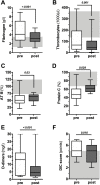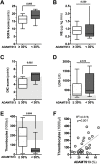Effect of therapeutic plasma exchange on endothelial activation and coagulation-related parameters in septic shock
- PMID: 32122366
- PMCID: PMC7053051
- DOI: 10.1186/s13054-020-2799-5
Effect of therapeutic plasma exchange on endothelial activation and coagulation-related parameters in septic shock
Abstract
Background: A dysbalanced coagulation system is part of the pathological host response to infection in sepsis. Activation of pro-coagulant pathways and attenuation of anti-coagulant activity ultimately lead to microvascular stasis and consequent organ failure. No treatment approaches specifically targeting this axis are available. We explored the effects of therapeutic plasma exchange (TPE) on microvascular coagulation dysbalance in septic shock.
Methods: We conducted a prospective single-center study enrolling 31 patients with early septic shock (onset < 12 h) requiring high doses of norepinephrine (NE > 0.4 μg/kg/min). Clinical and biochemical data, including measurement of protein C; a disintegrin and metalloprotease with a thrombospondin type 1 motif, member 13 (ADAMTS13); and von Willebrand factor antigen (vWF:Ag), were obtained before and after TPE against fresh frozen plasma.
Results: Antithrombotic acting proteins such as antithrombin-III (ATIII) and protein C were markedly reduced in septic patients, but their activity increased after TPE (ATIII, 51% (41-61) vs. 63% (48-70), p = 0.029; protein C, 47% (38-60) vs. 62% (54-69), p = 0.029). Median ADAMTS13 activity was increased by TPE from 27 (21-42) % before to 47 (38-62) % after TPE (p < 0.001). In contrast, vWF:Ag was elevated and could be reduced by TPE (353 (206-492) IU/dL vs. 170 (117-232) IU/dL, p < 0.001). Regression analysis yielded a correlation between ADAMTS13 activity and platelet count (p = 0.001, R2 = 0.316).
Conclusions: Septic shock was associated with activation of pro-coagulant pathways and simultaneous depletion of anti-coagulant factors. TPE partially attenuated this dysbalance by removing pro- and by replacing anti-coagulant factors.
Trial registration: ClinicalTrials.gov, NCT03065751. Retrospectively registered on 28 February 2017.
Keywords: ADAMTS-13; Extracorporeal treatment; Plasmapheresis; Septic shock; von Willebrand factor.
Conflict of interest statement
The authors declare that they have no competing interests.
Figures




References
-
- Angus DC, van der Poll T. Severe sepsis and septic shock. N Engl J Med. 2013;369(21):2063. - PubMed
MeSH terms
Substances
Associated data
LinkOut - more resources
Full Text Sources
Medical
Miscellaneous

